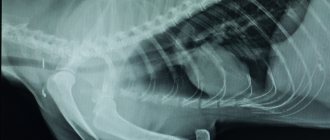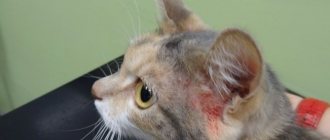It is probably difficult to find a person who, at least once in his life, has not seen or heard about advertising of “miracle remedies” intended for the treatment of psoriasis. Moreover, people's interest in this topic is constantly high. This is due to the severity and aesthetic unpleasantness of the disease. Few people think about whether psoriasis is possible in cats. However, veterinarians also have no consensus on this matter.
Symptoms of eczema in cats
Despite the variety of causes leading to the development of the disease, the owner should know the characteristic symptoms of the skin disease:
- Redness of the skin . Erythema is observed at the initial stage of development of the pathology.
- Itching. The animal is worried and tries to scratch the affected area.
- When palpating the skin, an increase in local temperature may be observed.
- Bubbles are found on the damaged area .
Eczema
The listed clinical signs are characteristic of the initial stage of development of both dry and weeping eczema. After the formation of vesicles on the skin, each form of the disease has its own characteristic signs. So, with dry eczema, the owner will observe drying of the pustules and peeling of the epidermis.
When the form becomes wet, the resulting bubbles spontaneously open. Infection with microorganisms leads to the appearance of ulcers, weeping erosion, and pustules. Weeping crusts and scales are found on damaged skin.
The general condition of the pet depends on the extent of skin damage, the type and stage of the disease. Constant itching leads to decreased appetite, decreased body weight, and decreased body resistance to infections. The animal noticeably weakens and is in a depressed state.
Causes
The following factors contribute to the occurrence of eczema:
- Traumatic.
- Neuropathic.
- Reflex.
- Interior.
Traumatic eczema
It occurs as a result of damage from accessories rubbing the skin, arthropod bites, frostbite, burns, and trauma from the claws of the cats themselves. The disease occurs in a weeping form and quickly stops after its cause is eliminated.
Neuropathic eczema
It is the result of stress or a congenital anomaly. This type of eczema is characterized by symmetrical bilateral skin lesions. It occurs in dry and wet form. The disease is characterized by remissions and exacerbations under the influence of stress factors.
Reflex eczema
It is a hypersensitive response to a stimulus. The reaction occurs under the influence of the following allergens:
- Arthropod saliva.
- Household items.
- Food allergens.
- Atopic dermatitis.
- Dust.
- Accessories.
Internal factors
Internal causes of eczema are associated with organ pathologies, irrational feeding, and hormonal perversions. Signs of the disease disappear when the factor that caused them is eliminated.
Classification of the disease according to its causes
Due to the occurrence of eczema in cats, it is divided into 4 large groups. Despite the similar symptoms, they all require different treatment methods.
Traumatic
This form of pathology occurs when insect bites and any injuries (frostbite, burns, friction of the collar) affecting the skin. In most cases, it develops as a weeping ulcer.
Neuropathic
The neuropathic form develops against the background of disturbances in the functioning of the autonomic nervous system, which is responsible for the reaction of internal organs to stimuli. It is caused by congenital genetic pathologies and some infections (distemper), which give complications to the central nervous system.
May manifest as peeling or erosive formations. It responds poorly to drug therapy and has a poor prognosis.
Reflex
Occurs when hypersensitivity to certain irritants (fabrics, detergents, pollen, food, flea saliva). This reaction of the body is called atopic dermatitis. This form is treated with antihistamines, which suppress the main symptoms.
Arising due to internal reasons
Internal causes include pathologies of the urinary tract, prolonged stress, diseases of the gastrointestinal tract, helminthiases and infections. The risk group includes animals with chronic diseases, elderly pets and kittens with weak immune systems.
How does the disease manifest itself?
Because of the fur of cats, the owner cannot always detect the symptoms of eczematous pathology in his pet. However, the unbearable itching of the animal can alert him.
When examining the animal, you can notice inflamed, reddened skin at the site of scratching. Here she is tight and hot.
The situation is aggravated by the constant trauma of the claws to the inflamed area, the penetration of pathogenic bacteria into the scratches, the formation of small nodules and watery blistering rashes there.
Next, these bubbles open, pyogenic contents infected with bacteria are released from them, which gives rise to weeping areas, erosion, ulcers, and rotting of the epidermis.
The main location of this disease in cats is observed in the area:
- Back to end of tail;
- Ear areas.
be careful
People suffering from psoriasis often make one big mistake:
The patient is trying to eliminate the external signs of the disease, but eliminating the external manifestations of psoriasis does not solve the problem from the inside.
Roughly speaking, even if it is possible to remove the signs of psoriasis from the outside and put the skin in order, inside the body the disease continues to devour the autoimmune system, which provokes severe diseases, many of which are fatal. Particularly scary is the fact that psoriasis can provoke cancerous tumors.
The only remedy that is currently available for self-use by patients with psoriasis is the special product “PsoriControl”, which is available at a reduced price. Read the details in the official source.
- Is it possible to get infected with psoriasis1.2
- What factors lead to exacerbation of the disease1.3
- How dangerous is psoriasis1.4
- Psoriasis - how to get rid of a deadly autoimmune disease?1.5
- Is psoriasis contagious or not?2 Relationships and psoriasis2.1
Treatment of the disease
External and internal factors are involved in the development of disease symptoms in cats.
External factors often include:
- Wool dirt;
- Constant friction;
- The influence of parasites;
- Using soap when bathing an animal;
- High or low temperatures;
- Microbial infection.
Internal factors that can cause weeping eczema in cats include:
- Weak immunity;
- Endocrine pathology;
- Ovarian dysfunction;
- Diseases of internal organs.
After the main factors provoking the disease are determined, the veterinarian determines how to treat the animal and makes the necessary prescriptions.
The general tactics used to treat eczema in cats is complex drug therapy. This includes drugs of both general and local action:
- First of all, they prevent the animal from becoming infected with blood-sucking insects and deworm it.
- Eliminate the threat of mechanical damage to the skin (remove the collar, prescribe antipruritic drugs to the animal).
- They normalize metabolism and strengthen the immune system with the help of immunomodulators and drugs that stimulate the immune system.
- It is very important to eliminate the danger of allergic reactions, thereby removing the sensitivity of the skin. For this, a complex of antihistamines is prescribed.
- Sedatives and tranquilizers are prescribed in order to relieve the animal from the effects of stress, neurotic disorders, and severe itching.
- Droppers with sodium chloride and sodium thiosulfate are prescribed to detoxify the body and complete antiallergic therapy.
- To relieve skin inflammation, topical hormonal preparations (Hydrocortisone ointment) are used.
- Vitamin therapy (vitamins B, C, D), as well as nicotinic and folic acid, is designed to restore immunity and strengthen the nervous system.
We suggest you read: Feeding rabbits with grass, can rabbits be given fresh grass?
To prevent eczema from reoccurring, treatment should include therapy for concomitant diseases. Without this, it is impossible to achieve a lasting effect:
- for a bacterial infection, antibiotic therapy is necessary;
- Antifungal drugs are used to treat fungal infections;
- the functioning of the gastrointestinal tract is regulated with the help of probiotic and enzyme preparations.
ethnoscience
The disease responds well to treatment using traditional medicine. But before using them, you should consult your doctor and get his recommendations.
- To disinfect the skin, wipe with infusions of chamomile, burdock leaves, and hay dust.
- Decoctions of oak bark or mallow have an astringent effect.
- St. John's wort oil helps with dry eczema, as it actively promotes the regeneration of skin cells.
- Applications of aloe juice and celandine juice heal the surface of the wound and stimulate local immunity.
It is very important to optimize your diet by eliminating foods that can cause allergies in your cat.
Classification by type of manifestation
Symptoms and treatment of eczema in cats directly depend on the type of its manifestation. The most dangerous are bursting pustules, which increase the affected area and cause tissue death.
Wet look
This species is easily identified by its wet and shiny surface. Bubbles with pus burst on their own or under the influence of sharp claws scratching the skin until it bleeds. The weeping lesion is not limited to one area and gradually grows, forming a huge ulcer oozing with pus or ichor.
Dry look
If the exudate resolves, the papules gradually harden and peel off. The skin at the site of the lesion begins to peel off and dandruff forms. This type of eczema in cats is called dry. Its main danger is the possibility of degeneration into a weeping appearance due to inflammation of the scratches. For this reason, it is recommended to treat the disease already at the erythematous stage.
Is psoriasis possible in cats: we answer the question in detail
It is probably difficult to find a person who, at least once in his life, has not seen or heard about advertising of “miracle remedies” intended for the treatment of psoriasis. Moreover, people's interest in this topic is constantly high. This is due to the severity and aesthetic unpleasantness of the disease. Few people think about whether psoriasis is possible in cats. However, veterinarians also have no consensus on this matter.
Symptoms of the disease
An attentive owner can recognize the onset of the disease in a cat. It is characterized by special features. This should be a signal to urgently show the animal to a veterinarian.
- The disease often debuts in young animals, whose age does not exceed 1-2 years.
- Skin itching, localized on the neck, along the spine or on the muzzle, forces the animal to scratch these places again and again and lick them.
- The skin on the affected areas is tense and inflamed. By touching it, you can feel a local increase in temperature.
- The fur here thins out, making it possible to notice the appearance of rashes.
- In advanced cases, the eczematous rash takes the form of ulcerations or ulcers.
- The appearance of crusts of dried exudate indicates the beginning of the healing stage.
Forecast and consequences
Further prognosis depends on timely diagnosis, treatment and neglect of the disease. The sooner therapy is started, the more optimistic the prognosis. It is important to prevent the pathology from passing into the acute stage, in which case the lesions will become more extensive.
To avoid complications, you must follow all doctor's recommendations. It is necessary to ensure that the dog does not scratch the affected areas. Otherwise, an inflammatory process and other dermatological diseases may occur against its background.
Types of disease
Depending on the reasons causing the development of the disease, veterinarians distinguish several types of weeping eczema in cats.
Traumatic
This type of eczematous skin lesions in cats is directly related to traumatic or irritating factors, and these are:
- Collars;
- Harnesses;
- Bites from fleas, ticks or other insects;
- Deep scratching;
- Burns or frostbite.
Neuropathic
This disease is associated with the manifestation of autonomic disorders in cats. It can be:
- Panleukopenia;
- Stress;
- Nervous disorders.
In this case, the symptoms of eczematous manifestations of this type of disease are accompanied by itching, increased hair loss in the animal, and symmetrically located affected areas.
Reflex
This type of eczematous pathology in cats is accompanied by severe itching, which is a consequence of:
- Hypersensitivity to detergents, kerosene or alkalis;
- Heavy contamination of the animal;
- Kidney or liver diseases;
- Overweight;
- Deficiency of animal protein or vitamins in the body;
- Hormonal imbalance;
- Insect or parasite bites.
We invite you to read: How long does pregnancy last in cats of the British breed, stages, exact numbers and days
Why do wet bald spots appear?
One of the common reasons for the appearance of one or more bald spots in a cat is injury. Representatives of the species are known for restlessness and activity, especially during the mating period, when each individual defends its own territory. If the pet simply ran into a stronger opponent and lost a tuft of hair, the spot will not itch and will quickly heal.
You might be interested in: How to help a cat if he is coughing as if he is choking?
However, another development of events is also possible. You may notice a wet, bald spot on your cat, which would be classified as a bite wound. Such a bald spot does not heal for a long time, and the ichor and necrotic exudate oozing from it resemble rotting meat in smell and color. There may be several reasons for the appearance of a wet spot:
- Burns caused by prolonged exposure of the fur to sunlight;
- Thermal burns due to open flame, steam or electric current;
- Chemical burns;
- Problems with local blood circulation associated with diseases of the cardiovascular system, thrombosis, the presence of parasites in the body, etc.;
- Eczema, dermatitis (atopic or allergic) and other skin ailments, including fungal ones;
- Prolonged mechanical irritation. For example, a wet bald spot on a cat’s neck may appear due to an incorrectly selected flea collar;
- Transformation of an ordinary abrasion into a weeping wound, which turned out to be infected with pathogenic microflora;
Important! In order to determine whether the healing process of a bare spot is natural or proceeds with complications, resort to the help of your main “allies” - smell and visual inspection. If the stain shows discharge of pus and a cloudy substance, and it smells extremely unpleasant, you should consult a specialist. Owners of long-haired beauties should be on guard, because bald spots in their thick fur can be noticed too late.
Useful video
For information on skin diseases in cats, watch this video:
Similar articles
- The cat scratched its ear until it bled: what to do if it itches... Tumors cause anxiety in the cat, she shakes her head, scratches the diseased organ. ... Eczema, dermatitis, allergies can also be the reason why a cat... Read more
- How to determine ringworm in a cat, what it is and how...
When making a diagnosis, it is necessary to distinguish ringworm in a cat from diseases with similar clinical signs: eczema, pyoderma... Read more - How to treat ringworm in a cat, what to smear and treat...
Ringworm (eczema). … Clinical manifestations. Before you treat lichen in cats, you need to understand what type of lichen your pet has. Read more - A cat has tubercles on its ears: how to treat it, what to do if...
Every owner of a furry beauty should know what subcutaneous mites are in cats. ... Eczema. Read more - Ringworm in a domestic cat: where could it come from?
Adult cats rarely get sick. The cat has ringworm on her nose. ... Ringworm in pets can be confused with other diseases: eczema... Read more
Preventing eczema in cats
From the point of view of veterinary specialists, the owner can adhere to the following preventive measures for a difficult-to-treat disease:
- keeping the animal in a clean, dry and warm room;
- maintaining the pet’s personal hygiene;
- preparing a diet taking into account the physiological state of the animal;
- use of vitamins and mineral supplements as recommended by a doctor;
- undergoing regular preventive examinations;
- timely treatment of diseases of internal organs.
Eczema in domestic cats is one of the most difficult to treat skin diseases, characterized by a complex pathological development mechanism. The disease is accompanied by severe itching, anxiety of the animal, and deterioration of the general condition. The disease requires long-term and well-chosen treatment, taking into account the stage of the process. The most unfavorable prognosis is for the weeping form of the disease. For dry eczema, the prognosis is guarded.
How to relieve the condition of our beloved furbabies
It is worth noting that treatment of weeping eczema in cats should only be carried out under the supervision of a qualified specialist.
Communication with the audience: It is at this point in our story that we want to warn you against rash actions.
Has your cat recently begun to lose hair, and underneath it appear weeping, rotting areas of skin?
Our advice!
Go to the vet immediately!
Do not treat the animal yourself!
This can lead to unpredictable consequences!
The treatment process should be directed and controlled only by a doctor!
To prescribe adequate treatment, the veterinarian must take into account the condition of the animal, the severity of the disease, and visual symptoms.
To confirm his version, he may additionally order a scraping from the affected area to examine its material.
Before starting the main treatment, it is necessary to eliminate all possible causes of the symptoms of the disease and its predisposing factors.
Typically, veterinarians provide medical care with traditional patented drugs. Initially, the animal is prepared for local treatment by first cutting off its hair in the affected area and disinfecting the area with alcohol or ordinary hydrogen peroxide.
At the same time, the main group of pharmacological drugs includes:
- Ointments with a moisturizing or astringent effect;
- Antiseptics that destroy pathogenic microorganisms;
- Complex of vitamins and minerals;
- Immunomodulators;
- Antibiotics for maintenance therapy.
Types and symptoms of eczema
Veterinarians distinguish three main forms of the disease.
The disease occurs in three forms - acute, subacute and chronic . Weeping eczema can occur in any course, although the chronic form most often occurs in the form of flaky crusts.
Acute form
The acute form is characterized by a variety of rashes.
- Both dry and wet lesions may be present in one area.
- The erythematous stage is manifested by areas of red spots that are itchy and hot to the touch, which the animal can periodically scratch, which provokes infection. Such areas are accompanied by pain.
- The erythematous stage turns into the papules stage, during which compactions the size of a small pea appear.
- Over time, the seals form bubbles filled with a liquid that looks like whey.
- Further, depending on the development of the disease, the papules either dry out and become covered with a dense crust, or burst on their own or as a result of scratching.
- Bursting blisters create a favorable environment for the development of pyogenic infection, which leads to the formation of pustules, which grow into extensive wet lesions called weeping eczema.
- Free access of air leads over time to drying out and crusting of wet lesions.
- Sore areas under the collar that do not have access to air continue to grow and become infected, which can lead to further complications.
The illness can last about a month. The main difference in the animal’s behavior is the constant scratching of the diseased area.
The prognosis for acute cases is cautious.
Chronic form
Therapy for the chronic form will require a long time.
The chronic form is difficult to treat, and the treatment process continues for quite a long period.
Is psoriasis contagious or not?
I decided to answer questions that interest many, those who encounter people with psoriasis. People ask these questions.
- How is psoriasis transmitted?
- Is psoriasis contagious?
- Is psoriasis transmitted?
- Is psoriasis inherited?
- Is psoriasis transmitted by contact?
- Is psoriasis transmitted sexually?
- Can you get psoriasis?
- Is psoriasis a contagious disease or what?
In our society, it is often considered inappropriate to talk about your illness. And several of the richest families in the United States are not ashamed of the fact that psoriasis is their hereditary disease. And they allocate huge amounts of money for research and equipping clinics. Patients with psoriasis, when faced with unfriendly people who, out of ignorance, are afraid of infection, gradually withdraw from society, limiting themselves on a subconscious level.
It is clear that people do not want to offend him, but just a few disapproving glances, behind which lies the unpronounceable “Don’t come near, you are contagious!”, can drive you into deep depression. And then patients begin to feel embarrassed about their illness, ashamed of it and limit their circle of friends and acquaintances.
The uncertainty and fear that people experience when they first see what psoriasis looks like is mostly generated by the fear of getting infected, naturally asking the question, can you get psoriasis? or not. The instinct of self-preservation, in this case an attempt to protect oneself from possible danger when communicating with people with psoriasis. Unsightly symptoms of psoriasis give rise to doubt, excessive caution and various speculations. One of the speculations is whether psoriasis is contagious?
In fact, this disease cannot be transmitted from a sick person to a healthy person either through kissing, or through everyday contact, or through sexual contact, or through contact with affected skin, or caring for a sick person, or using common objects (cups, towels, etc.). ) cannot lead to infection with psoriasis, psoriasis is not an infection.
Psoriasis is not a contagious disease, it is not transmitted through blood in one word, psoriasis is not contagious. The occurrence of psoriasis is not associated with pathogenic microorganisms, but with endocrine disorders, metabolic disorders, damage to the immune system, for this reason, a patient with psoriasis is not dangerous to others.
Psoriasis is also called lichen planus, but unlike other types of lichen, psoriasis is not a contagious disease. You cannot become infected from another person under any circumstances. If one person in the family gets psoriasis, and then the same disease is diagnosed in the rest, then the reason lies in a common hereditary predisposition, and not in physical contact with the patient; psoriasis is inherited.
Predisposition to psoriasis is passed on from parents to children. If one parent is sick, then the probability of psoriasis in the child is approximately 20-30%, and if both parents are sick - up to 75%. However, this does not mean that psoriasis will definitely appear, because... Many factors play a role in the occurrence of psoriasis; “hereditary predisposition” is only a potential possibility for the manifestation of the disease. And here the length of the disease, as well as the absence of clinical manifestations of psoriasis in relatives, does not matter. It is impossible to say for sure that psoriasis is inherited, because the disease has been little studied.
Prevention measures
Prevention of eczema in cats is a set of measures that reduce the risk of triggering factors. It includes several areas:
- skin hygiene;
- fight against skin parasites and timely deworming;
- balanced nutritious nutrition;
- prevention of allergic reactions;
- timely replacement of collars, harnesses and other accessories that do not fit the animal in size and that rub the skin;
- prevention of severe stress;
- It is important to avoid severe overheating or hypothermia of the body.
After the main symptoms have been relieved and the treatment of the animal has been completed, monitoring of the health condition cannot be weakened. Otherwise, the disease may recur. If you have the slightest signs, you should immediately consult a doctor.
Great importance is attached to general and differential diagnosis, which is impossible to carry out at home. Only a correct diagnosis and competent therapy provide confidence that the disease will be defeated.
The mechanism of development of eczema in cats
Before starting treatment for a sick cat, the owner should inquire about the mechanism of development of the disease. Experts believe that for some reason there is a violation of blood and lymph circulation in an area of the skin. At this stage, redness of the skin is observed.
In the tissues of the dermis, concentrations of poisons, toxins, and waste products accumulate. These phenomena lead to intoxication of the upper layers of the epidermis and cell hypoxia. The affected skin becomes hypersensitive to external or internal irritants. Sensitization occurs. Due to irritation of the nerve endings, the animal experiences itching. The processes of intoxication and sensitization trigger the formation of bubbles on the pet’s skin.
Papules rise above the surface of the skin and are covered with scales. This is how the dry form of eczema develops.
With the weeping form of the disease, serous exudate begins to form in the superficial layers of the skin. In place of the papules, vesicles form. When they are opened, the contents are released onto the surface of the skin. This forms a pustule with purulent contents. The wet stage is accompanied by erosion. When the pathological process subsides, crusts form in place of the pustules.
The scaly stage is characterized by the formation of horny plates in the upper layers of the epidermis in the form of a pityriasis-like plaque. This phase of the pathological process is characterized by recovery of the skin and hair.
Changes in the microstructure of the upper layers of the epidermis weaken the barrier and protective function of the skin and negatively affect the mental and general health of the pet.
Diagnostics
To find out the cause of the development of eczema, an examination is carried out using laboratory tests and the exclusion method. The first action is to change your diet. After receiving the results of blood biochemistry, ultrasound of the kidneys, liver, ovaries, and uterus, the treatment is adjusted. Self-medication makes diagnosis difficult. The use of local medications slightly improves well-being and alleviates symptoms. Therefore, no action should be taken without the knowledge of your veterinarian.











